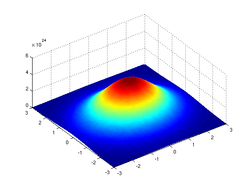Schwartz space
In mathematics, Schwartz space is the function space of functions all of whose derivatives are rapidly decreasing (defined rigorously below). This space has the important property that the Fourier transform is an automorphism on this space. This property enables one, by duality, to define the Fourier transform for elements in the dual space of S, that is, for tempered distributions. The Schwartz space was named in honour of Laurent Schwartz by Alexander Grothendieck.[1] A function in the Schwartz space is sometimes called a Schwartz function.

Definition
The Schwartz space or space of rapidly decreasing functions on Rn is the function space
where α, β are multi-indices, C∞(Rn) is the set of smooth functions from Rn to C, and
Here, sup denotes the supremum, and we again use multi-index notation.
To put common language to this definition, we could note that a rapidly decreasing function is essentially a function f(x) such that f(x), f′(x), f′′(x), ... all exist everywhere on R and go to zero as x → ±∞ faster than any inverse power of x. In particular, S(Rn) is a subspace of the function space C∞(Rn) of infinitely differentiable functions.
Examples of functions in the Schwartz space
- If i is a multi-index, and a is a positive real number, then
- Any smooth function f with compact support is in S(Rn). This is clear since any derivative of f is continuous and supported in the support of f, so (xαDβ) f has a maximum in Rn by the extreme value theorem.
Properties
- S(Rn) is a Fréchet space over the complex numbers.
- From Leibniz' rule, it follows that S(Rn) is also closed under pointwise multiplication: if f, g ∈ S(Rn), then fg ∈ S(Rn).
- If 1 ≤ p ≤ ∞, then S(Rn) ⊂ Lp(Rn).
- The space of all bump functions, C∞
c(Rn), is included in S(Rn). - The Fourier transform is a linear isomorphism S(Rn) → S(Rn).
- If f ∈ S(R), then f is uniformly continuous on R.
References
- ↑ TerzioĞglu, T. (1969). On Schwartz spaces. Mathematische Annalen, 182(3), 236–242.
- Hörmander, L. (1990). The Analysis of Linear Partial Differential Operators I, (Distribution theory and Fourier Analysis) (2nd ed.). Berlin: Springer-Verlag. ISBN 3-540-52343-X.
- Reed, M.; Simon, B. (1980). Methods of Modern Mathematical Physics: Functional Analysis I (Revised and enlarged ed.). San Diego: Academic Press. ISBN 0-12-585050-6.
- Stein, Elias M.; Shakarchi, Rami (2003). Fourier Analysis: An Introduction (Princeton Lectures in Analysis I<). Princeton: Princeton University Press. ISBN 0-691-11384-X.
This article incorporates material from Space of rapidly decreasing functions on PlanetMath, which is licensed under the Creative Commons Attribution/Share-Alike License.